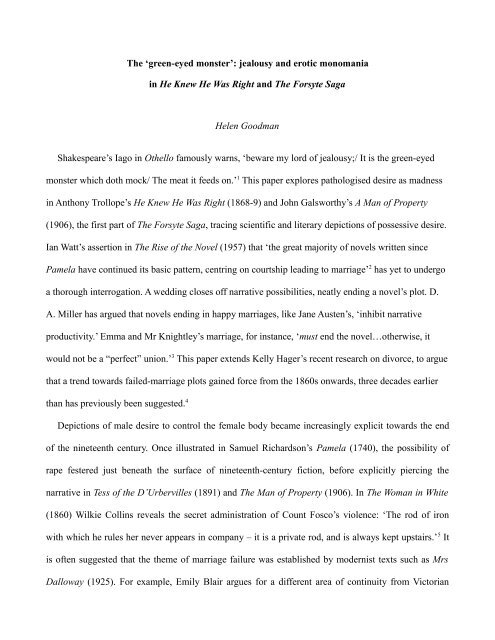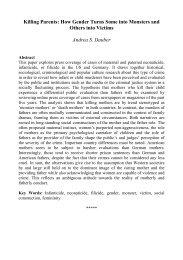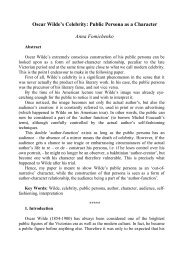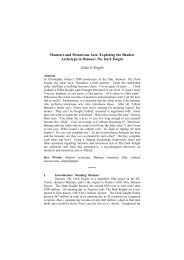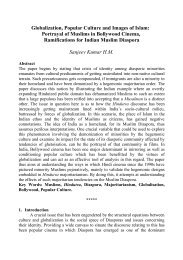The 'green-eyed monster': jealousy and erotic monomania in He ...
The 'green-eyed monster': jealousy and erotic monomania in He ...
The 'green-eyed monster': jealousy and erotic monomania in He ...
You also want an ePaper? Increase the reach of your titles
YUMPU automatically turns print PDFs into web optimized ePapers that Google loves.
<strong>The</strong> ‘green-<strong>eyed</strong> monster’: <strong>jealousy</strong> <strong>and</strong> <strong>erotic</strong> <strong>monomania</strong><br />
<strong>in</strong> <strong>He</strong> Knew <strong>He</strong> Was Right <strong>and</strong> <strong>The</strong> Forsyte Saga<br />
<strong>He</strong>len Goodman<br />
Shakespeare’s Iago <strong>in</strong> Othello famously warns, ‘beware my lord of <strong>jealousy</strong>;/ It is the green-<strong>eyed</strong><br />
monster which doth mock/ <strong>The</strong> meat it feeds on.’ 1 This paper explores pathologised desire as madness<br />
<strong>in</strong> Anthony Trollope’s <strong>He</strong> Knew <strong>He</strong> Was Right (1868-9) <strong>and</strong> John Galsworthy’s A Man of Property<br />
(1906), the first part of <strong>The</strong> Forsyte Saga, trac<strong>in</strong>g scientific <strong>and</strong> literary depictions of possessive desire.<br />
Ian Watt’s assertion <strong>in</strong> <strong>The</strong> Rise of the Novel (1957) that ‘the great majority of novels written s<strong>in</strong>ce<br />
Pamela have cont<strong>in</strong>ued its basic pattern, centr<strong>in</strong>g on courtship lead<strong>in</strong>g to marriage’ 2 has yet to undergo<br />
a thorough <strong>in</strong>terrogation. A wedd<strong>in</strong>g closes off narrative possibilities, neatly end<strong>in</strong>g a novel’s plot. D.<br />
A. Miller has argued that novels end<strong>in</strong>g <strong>in</strong> happy marriages, like Jane Austen’s, ‘<strong>in</strong>hibit narrative<br />
productivity.’ Emma <strong>and</strong> Mr Knightley’s marriage, for <strong>in</strong>stance, ‘must end the novel…otherwise, it<br />
would not be a “perfect” union.’ 3 This paper extends Kelly Hager’s recent research on divorce, to argue<br />
that a trend towards failed-marriage plots ga<strong>in</strong>ed force from the 1860s onwards, three decades earlier<br />
than has previously been suggested. 4<br />
Depictions of male desire to control the female body became <strong>in</strong>creas<strong>in</strong>gly explicit towards the end<br />
of the n<strong>in</strong>eteenth century. Once illustrated <strong>in</strong> Samuel Richardson’s Pamela (1740), the possibility of<br />
rape festered just beneath the surface of n<strong>in</strong>eteenth-century fiction, before explicitly pierc<strong>in</strong>g the<br />
narrative <strong>in</strong> Tess of the D’Urbervilles (1891) <strong>and</strong> <strong>The</strong> Man of Property (1906). In <strong>The</strong> Woman <strong>in</strong> White<br />
(1860) Wilkie Coll<strong>in</strong>s reveals the secret adm<strong>in</strong>istration of Count Fosco’s violence: ‘<strong>The</strong> rod of iron<br />
with which he rules her never appears <strong>in</strong> company – it is a private rod, <strong>and</strong> is always kept upstairs.’ 5 It<br />
is often suggested that the theme of marriage failure was established by modernist texts such as Mrs<br />
Dalloway (1925). For example, Emily Blair argues for a different area of cont<strong>in</strong>uity from Victorian
novelists to Woolf, <strong>and</strong> writes that ‘Woolf’s depiction of fem<strong>in</strong><strong>in</strong>ity resonates with the depictions of<br />
Gaskell <strong>and</strong> Oliphant as she simultaneously re<strong>in</strong>vents the novel <strong>and</strong> revises the marriage plot.’ 6 Mary<br />
Poovey places this narrative shift earlier, with Thomas Hardy’s 1890s fiction, tak<strong>in</strong>g ‘as its subject<br />
marital unhapp<strong>in</strong>ess as well as bliss.’ This paper, however, will argue for its appearance earlier still, <strong>in</strong><br />
the 1860s.<br />
In <strong>The</strong> Forsyte Saga, Galsworthy makes a shock<strong>in</strong>gly frank contribution to debates about marriage<br />
based on servitude <strong>and</strong> mastery. Yet more controversially, Galsworthy exposes the tragedy of madness<br />
fuelled by sexual desire with ‘a man enslaved by his own possessive <strong>in</strong>st<strong>in</strong>ct, who couldn't see the sky<br />
for it, or even enter fully <strong>in</strong>to what another person felt!’ 7 By 1906 Galsworthy could portray marital<br />
rape: an act which I argue underlies concerns about marriage <strong>and</strong> a wife’s <strong>in</strong>dependence <strong>in</strong> earlier<br />
fiction. Just fifteen years before the publication of this section of the saga, Hardy’s Tess of the<br />
D’Urbervilles sc<strong>and</strong>alised readers with its portrayal of the raped woman as a morally pure victim.<br />
Galsworthy’s Irene is similarly <strong>in</strong>nocent of all blame for the violence she experiences. Despite its early<br />
date, Trollope’s novel also subverts normative treatments of marriage <strong>in</strong> Victorian fiction, present<strong>in</strong>g<br />
<strong>monomania</strong> fuelled rather than cured by marriage.<br />
Follow<strong>in</strong>g the fem<strong>in</strong>ist tradition, the failed-marriage plot is widely understood as concerned<br />
‘primarily with the matter of female agency: it tends to revolve around a wife leav<strong>in</strong>g her husb<strong>and</strong>.’ 8<br />
However, this view is predicated on the assumption that only female agency is restricted <strong>and</strong><br />
problematized by n<strong>in</strong>eteenth-century marriage laws. I suggest that Trollope frames the failed-marriage<br />
plot primarily as a man’s plot. James Eli Adams has expla<strong>in</strong>ed the critical shy<strong>in</strong>g away from<br />
mascul<strong>in</strong>ity studies, writ<strong>in</strong>g that it ‘has been resisted by those concerned that dwell<strong>in</strong>g on the<br />
complexities <strong>and</strong> burdens of mascul<strong>in</strong>e identity would serve to obscure, <strong>and</strong> thereby to re<strong>in</strong>force, the<br />
brute realities of male dom<strong>in</strong>ation aga<strong>in</strong>st which fem<strong>in</strong>ist analyses were <strong>and</strong> are <strong>in</strong> the first place<br />
directed.’ 9 Such studies also risk fall<strong>in</strong>g <strong>in</strong>to what Eve Kosofsky Sedgwick terms a ‘vast national wash
of mascul<strong>in</strong>e self-pity.’ 10 By exam<strong>in</strong><strong>in</strong>g pathological male desire <strong>and</strong> madness, <strong>in</strong>herently exacerbat<strong>in</strong>g<br />
female repression, this paper beg<strong>in</strong>s to redress gender imbalances <strong>in</strong> studies of Victorian psychology,<br />
illum<strong>in</strong>at<strong>in</strong>g <strong>in</strong>stances of male dom<strong>in</strong>ation, while resist<strong>in</strong>g the assumption that women were the only<br />
‘victims’ of restricted agency <strong>in</strong> socio-psychological terms.<br />
Trollope’s writ<strong>in</strong>g is deeply rooted <strong>in</strong> n<strong>in</strong>eteenth-century psychological theory about madness, 11<br />
most notably Jean-Étienne Esquirol’s term ‘<strong>monomania</strong>’, a newly-labelled form of <strong>in</strong>sanity. 12 Other<br />
medics of the period were broadly <strong>in</strong> agreement with Esquirol’s outl<strong>in</strong>es. In J. C. Prichard’s <strong>in</strong>fluential<br />
treatise (1837) he def<strong>in</strong>ed <strong>monomania</strong> as a form of <strong>in</strong>sanity ‘<strong>in</strong> which the underst<strong>and</strong><strong>in</strong>g is partially<br />
disordered or under the <strong>in</strong>fluence of some particular illusion, referr<strong>in</strong>g to one subject.’ 13 This idea was<br />
not, however, an entirely new one. In 1621 Robert Burton identified ‘love-melancholy’ <strong>and</strong> <strong>jealousy</strong> as<br />
significant forms of madness. This mania only showed itself when the patient thought or spoke about<br />
one particular subject: an idée fixe. 14 Esquirol’s conceptualisation of <strong>erotic</strong> <strong>monomania</strong> or ‘erotomania’<br />
expla<strong>in</strong>s that ‘ardent affections’, becom<strong>in</strong>g extreme, cause <strong>monomania</strong>cal symptoms. 15 Later def<strong>in</strong>itions<br />
described the violent symptoms shown <strong>in</strong> Galsworthy’s account. John Quackenbos, for <strong>in</strong>stance,<br />
writ<strong>in</strong>g a few months after Galsworthy, noted that erotomania, literally ‘rav<strong>in</strong>g love,’ may rema<strong>in</strong> <strong>in</strong> the<br />
imag<strong>in</strong>ation, or be ‘grossly sensual’, perverted <strong>and</strong> quite repulsive. 16<br />
Jealousy as a forerunner of madness was explored previously <strong>in</strong> novels such as Charles Reade’s<br />
Griffith Gaunt (1866). Ellen Wood’s sensation novel, St. Mart<strong>in</strong>’s Eve, published the same year,<br />
discussed the theme, but occurr<strong>in</strong>g <strong>in</strong> a female character. <strong>The</strong> Spectator reviewed Wood’s novel,<br />
compla<strong>in</strong><strong>in</strong>g that madness was trivialised, be<strong>in</strong>g used as a mere plot device, <strong>and</strong> that the author lacked<br />
‘the power to create Othello, or the art to pa<strong>in</strong>t, as Thackeray or Trollope might have done, the morbid<br />
passion <strong>in</strong> its naturalistic n<strong>in</strong>eteenth-century dress.’ 17 P. D. Edwards suggested that this review, together<br />
with Eliza Lynn L<strong>in</strong>ton’s Sow<strong>in</strong>g the W<strong>in</strong>d from 1867 may have <strong>in</strong>spired Trollope’s to write <strong>He</strong> Knew
<strong>He</strong> Was Right. 18 In Trollope’s protagonist the illness takes an Esquirolian melancholic, relatively chaste<br />
form, while Galsworthy’s protagonist, presented <strong>in</strong> this paper as his literary successor, displays highly<br />
sexualised, violent erotomania.<br />
<strong>He</strong> Knew <strong>He</strong> Was Right, the most detailed <strong>and</strong> extended portrait of male <strong>monomania</strong> <strong>in</strong> the Victorian<br />
canon, describes courtship <strong>in</strong> a mere two pages, swiftly skipp<strong>in</strong>g to events two years after marriage,<br />
contrary to Ian Watt’s generalisation. Suspect<strong>in</strong>g <strong>in</strong>correctly that his wife is conduct<strong>in</strong>g an affair with<br />
her ag<strong>in</strong>g godfather, Colonel Osborne, Louis Trevelyan gradually becomes mad with <strong>jealousy</strong>: a<br />
deterioration which Trollope repeatedly associates with his decl<strong>in</strong><strong>in</strong>g mascul<strong>in</strong>ity. <strong>He</strong>re Trollope jo<strong>in</strong>s a<br />
contemporary cultural discourse which associated manl<strong>in</strong>ess with good health, physically <strong>and</strong> mentally,<br />
perceiv<strong>in</strong>g mental distress as weakness <strong>in</strong> mascul<strong>in</strong>ity. Trollope demonstrates the failure of attempts to<br />
impose the male will, <strong>and</strong> the <strong>in</strong>evitable failure of attempts to force it, particularly when based on<br />
jealous passion. Hav<strong>in</strong>g dem<strong>and</strong>ed that Emily not receive Colonel Osborne at home, Louis soon notes<br />
that ‘so far he had hardly ga<strong>in</strong>ed much by the enforced obedience of his wife.’ 1 Louis is acutely aware<br />
that his behaviour actually threatens his status as a gentleman <strong>and</strong> as a man, <strong>and</strong> he berates himself for<br />
it: ‘<strong>He</strong> had meant to have acted <strong>in</strong> a high-m<strong>in</strong>ded, honest, manly manner; but circumstances had been<br />
so untoward with him, that on look<strong>in</strong>g at his own conduct, it seemed to him to have been mean, <strong>and</strong><br />
almost false <strong>and</strong> cowardly.’ 2 After Osborne’s first few visits to his wife, Trevelyan struggles with his<br />
irrationality:<br />
1 Ibid., p. 54.<br />
‘Though he believed himself to be a man very firm of purpose, his m<strong>in</strong>d had oscillated<br />
2 <strong>He</strong> Knew <strong>He</strong> Was Right, p. 55.
ackwards <strong>and</strong> forwards with<strong>in</strong> the last quarter of an hour between those two purposes of be<strong>in</strong>g<br />
round with his wife, <strong>and</strong> of begg<strong>in</strong>g her pardon for the words which he had already spoken. <strong>He</strong><br />
believed that he would best do his duty by that plan of be<strong>in</strong>g round with her; but then it would<br />
be so much pleasanter – at any rate so much easier, to beg her pardon…<strong>He</strong> could not live <strong>and</strong><br />
cont<strong>in</strong>ue to endure the feel<strong>in</strong>gs which he had suffered while sitt<strong>in</strong>g downstairs at his desk, with<br />
the knowledge that Colonel Osborne was closeted with his wife upstairs. It might be that there<br />
was noth<strong>in</strong>g <strong>in</strong> it. That his wife was <strong>in</strong>nocent he was quite sure. But nevertheless, he was<br />
himself affected by some feel<strong>in</strong>g which pervaded him <strong>in</strong> reference to this man, that all his<br />
energy was destroyed, <strong>and</strong> his powers of m<strong>in</strong>d <strong>and</strong> body were paralysed. <strong>He</strong> could not, <strong>and</strong><br />
would not, st<strong>and</strong> it. 19<br />
At the novel’s open<strong>in</strong>g Trevelyan’s agency was maximised, hav<strong>in</strong>g ‘all the world before him where to<br />
choose’, <strong>and</strong> be<strong>in</strong>g ‘a very pearl among men,’ 20 <strong>in</strong> stark contrast to the melancholic hermit, hid<strong>in</strong>g from<br />
his wife near Siena a few months later. Trevelyan develops the symptoms of erotomania described by<br />
Esquirol, appear<strong>in</strong>g dejected <strong>and</strong> pale.’ 21 Trollope’s diagnosis is explicit, as he describes Trevelyan as<br />
‘mono-maniacal.’ 22 <strong>He</strong> writes, ‘Now Trevelyan was, <strong>in</strong> truth, mad on the subject of his wife’s alleged<br />
<strong>in</strong>fidelity. <strong>He</strong> had ab<strong>and</strong>oned everyth<strong>in</strong>g that he valued <strong>in</strong> the world, <strong>and</strong> had made himself wretched <strong>in</strong><br />
every affair of life, because he could not submit to acknowledge to himself the possibility of error on<br />
his own part. For that, <strong>in</strong> truth, was the condition of his m<strong>in</strong>d.’ 23 Upon his death, the language of mania<br />
is used aga<strong>in</strong> as Trollope beg<strong>in</strong>s his f<strong>in</strong>al chapter with the words ‘At last the maniac was dead, <strong>and</strong> <strong>in</strong><br />
his last moments he had made such reparation as was <strong>in</strong> his power for the evil that he had done.’ 24 At<br />
Trevelyan’s death bed, his doctor observes that ‘his patient’s thoughts had been forced to dwell on one<br />
subject’, becom<strong>in</strong>g ‘distorted, untrue, jaundiced… mono-maniacal,’ 25 before the narrator announces
that ‘At last the maniac was dead.’ 26<br />
Trollope’s letters reveal that dur<strong>in</strong>g the writ<strong>in</strong>g of <strong>He</strong> Knew <strong>He</strong> Was Right he was <strong>in</strong> communication<br />
with psychologists, collect<strong>in</strong>g material for his fictional case study. Furthermore, there is evidence that<br />
this channel of <strong>in</strong>fluence was reciprocal <strong>in</strong> nature, with doctors read<strong>in</strong>g the novel as pseudo-authentic<br />
account of <strong>monomania</strong>. Trollope wrote to one physician, ‘I am gratified by the attention which your<br />
scientific analysis shews that you have given to the character of the unfortunate man which I attempted<br />
to draw <strong>in</strong> my novel,’ 27 demonstrat<strong>in</strong>g a two-way traffic of ideas between literary <strong>and</strong> scientific<br />
discipl<strong>in</strong>es.<br />
This <strong>in</strong>fluence is particularly <strong>in</strong>terest<strong>in</strong>g s<strong>in</strong>ce it demonstrates that novels were be<strong>in</strong>g read as realities <strong>in</strong><br />
themselves, rather than a mere reflection of them. Elizabeth Langl<strong>and</strong> has argued that novelists <strong>and</strong><br />
novels ‘do not simply reflect the contemporary ideology. Rather, by depict<strong>in</strong>g a material reality filled<br />
with <strong>and</strong> <strong>in</strong>terpreted through ideology, they also expose ideology.’ 28 I suggest that Langl<strong>and</strong>’s argument<br />
may be applied to psychology, as part of a wider argument about Victorian <strong>in</strong>terdiscipl<strong>in</strong>arity or<br />
perhaps more specifically, prediscipl<strong>in</strong>arity. Trollope’s correspondence with doctors, together with his<br />
clear knowledge of contemporary psychological theory, enabled him to expose a character study <strong>in</strong> a<br />
novel as a scientific case study.<br />
Trollope’s writ<strong>in</strong>g follows psychiatrists who <strong>in</strong>sisted that <strong>monomania</strong> stemmed primarily from<br />
personal matters rather than heredity, such as Forbes W<strong>in</strong>slow <strong>and</strong> J. G. Davey. <strong>The</strong> heightened<br />
suspicion <strong>and</strong> physical decl<strong>in</strong>e we observe <strong>in</strong> Trevelyan was central to the new conception of<br />
<strong>monomania</strong> as observed by Davey <strong>in</strong> 1855, when he wrote, ‘the vacillat<strong>in</strong>g countenance <strong>in</strong>dicates the<br />
condition of the dismal m<strong>in</strong>d; the eyes sunk <strong>in</strong> their hollow sockets… the looks restless <strong>and</strong> vacant.’ 29<br />
Galsworthy’s <strong>The</strong> Man of Property (published <strong>in</strong> 1906), set from 1886-7, centres on Soames<br />
Forsyte, a wealthy solicitor <strong>and</strong> art collector, <strong>and</strong> his marriage to the beautiful Irene <strong>He</strong>ron. To the
outside world, Soames appears to be an excellent husb<strong>and</strong>. His ma<strong>in</strong>tenance of an exterior of perfect<br />
gentlemanl<strong>in</strong>ess is, as for other abusive partners <strong>in</strong> Victorian literature, essential. In consequence of this<br />
process of keep<strong>in</strong>g up appearances, Irene’s father-<strong>in</strong>-law tells her, ‘I can’t th<strong>in</strong>k what you’re about. <strong>He</strong>’s<br />
a very good husb<strong>and</strong>!’ Irene’s answer, ‘almost <strong>in</strong>audible among the sounds of traffic’, is simply, ‘You<br />
are not married to him!’ Unable to underst<strong>and</strong> the problem, James asks, ‘What’s that got to do with it?<br />
<strong>He</strong>’s given you everyth<strong>in</strong>g you want. <strong>He</strong>’s always ready to take you anywhere, <strong>and</strong> now he’s built you<br />
this house <strong>in</strong> the country. It’s not as if you had anyth<strong>in</strong>g of your own… Well, I’ve warned you.’<br />
Galsworthy’s 1922 preface to the complete saga cites ‘possessive <strong>in</strong>st<strong>in</strong>cts’ <strong>and</strong> a ‘sense of home <strong>and</strong><br />
property’ as his primary concerns. Unlike Trevelyan’s, Forsyte’s suspicions about his wife’s <strong>in</strong>fidelity<br />
are correct. Galsworthy’s publication followed key writ<strong>in</strong>gs on repression by Krafft-Eb<strong>in</strong>g <strong>and</strong> Freud.<br />
Personal violation had been veiled <strong>in</strong>creas<strong>in</strong>gly th<strong>in</strong>ly <strong>in</strong> the fiction of preced<strong>in</strong>g decades. <strong>The</strong><br />
possibility of sexual violence haunts the narrative of sensation fiction on madness from the early 1860s.<br />
For D. A. Miller, rape can be figured as what Rol<strong>and</strong> Barthes terms the ‘symbolic mode’ of <strong>The</strong> Woman<br />
<strong>in</strong> White. This vague fear is present dur<strong>in</strong>g Anne <strong>and</strong> Walter’s first encounter, <strong>and</strong> later ‘what Fosco<br />
f<strong>in</strong>ally accomplishes when he reads Marian’s journal <strong>in</strong>time – is virtual rape.’ 30 Marian is ‘firmly<br />
ab<strong>and</strong>oned by Walter’s <strong>erotic</strong> <strong>in</strong>terest <strong>and</strong> forcibly seduced by Fosco’s… perhaps the most important<br />
fantasy feature of rape is the reaffirmation of the rapist’s unimpaired capacity to withdraw, the <strong>in</strong>tegrity<br />
of his body (if not his victim’s) recovered <strong>in</strong>tact. (Fosco, we recall, returns to Marian the journal he has<br />
<strong>in</strong>delibly signed, <strong>and</strong> she, eventually, is stuck with it.)’ 31 Hardy also considers this k<strong>in</strong>d of impr<strong>in</strong>t left<br />
by rape, question<strong>in</strong>g why Tess Durbeyfield should have been so doomed: ‘Why it was that upon this<br />
beautiful fem<strong>in</strong><strong>in</strong>e tissue, sensitive as gossamer, <strong>and</strong> practically blank as snow yet, there should have<br />
been traced such a coarse pattern as it was doomed to receive.’ 32<br />
<strong>The</strong> Forsyte Saga’s later date enabled Galsworthy to expose what had been implied <strong>in</strong> earlier
fiction. Although Irene’s rape takes place outside narrative space, we cannot doubt what the ‘<strong>in</strong>cident of<br />
the night before’ entailed. 33 <strong>The</strong> sight <strong>and</strong> sounds which haunt Soames afterwards are described with a<br />
sear<strong>in</strong>g clarity that was almost unth<strong>in</strong>kable for earlier writers. Galsworthy ironically writes, ‘<strong>The</strong><br />
morn<strong>in</strong>g after a certa<strong>in</strong> night on which Soames at last asserted his rights <strong>and</strong> acted like a man, he<br />
breakfasted alone.’ 34 This sudden aloneness cont<strong>in</strong>ues through the narrative, hav<strong>in</strong>g committed a legally<br />
permissible yet socially unspeakable act. Although at first this secrecy is reassur<strong>in</strong>g (‘One thought<br />
comforted him: No one would know – it was not the sort of th<strong>in</strong>g that she would speak about’), his<br />
isolation with his own doubt<strong>in</strong>g <strong>and</strong> <strong>in</strong>creas<strong>in</strong>gly <strong>in</strong>sane thoughts gradually becomes <strong>in</strong>tolerable.<br />
Hav<strong>in</strong>g been certa<strong>in</strong> of the rightness of his actions throughout his life, he is now plagued by doubt.<br />
Galsworthy writes,<br />
<strong>He</strong> ate steadily, but at times a sensation as though he could not swallow attacked him. Had he<br />
been right to yield to his overmaster<strong>in</strong>g hunger of the night before, <strong>and</strong> break down the<br />
resistance which he had suffered now too long from this woman who was his lawful <strong>and</strong><br />
solemnly constituted helpmate? <strong>He</strong> was strangely haunted by the recollection of her face, from<br />
before which, to soothe her, he had tried to pull her h<strong>and</strong>s – of her terrible smothered sobb<strong>in</strong>g,<br />
the like of which he had never heard, <strong>and</strong> still seemed to hear; <strong>and</strong> he was still haunted by the<br />
odd, <strong>in</strong>tolerable feel<strong>in</strong>g of remorse <strong>and</strong> shame he had felt, as he stood look<strong>in</strong>g at her by the<br />
flame of the s<strong>in</strong>gle c<strong>and</strong>le, before silently sl<strong>in</strong>k<strong>in</strong>g away. 35<br />
This assertion of legal rights is reconfigured by Soames’s guilt-wracked m<strong>in</strong>d as a violent crime,<br />
utterly <strong>in</strong>compatible with his self-identity <strong>and</strong> self-presentation as a gentleman. Dur<strong>in</strong>g his commute <strong>in</strong><br />
a first-class compartment on the Underground from Sloane Square to the City, ‘the smothered sobb<strong>in</strong>g
still haunted him.’ <strong>He</strong> opens <strong>The</strong> Times to distract himself, with a ‘rich crackle that drowns all lesser<br />
sounds’, <strong>and</strong> becomes ‘barricaded beh<strong>in</strong>d it’, but is confronted by news of violent acts: ‘<strong>He</strong> read of<br />
three murders, five manslaughters, seven arsons, <strong>and</strong> as many as eleven – a surpris<strong>in</strong>gly high number –<br />
rapes, <strong>in</strong> addition to many less conspicuous crimes,’ so that ‘<strong>in</strong>separable from his read<strong>in</strong>g,’ rises up ‘the<br />
memory of Irene’s tear-sta<strong>in</strong>ed face, <strong>and</strong> the sounds from her broken heart.’ 36<br />
<strong>He</strong>ar<strong>in</strong>g from his housekeeper that Irene has left him, Soames’s state deteriorates further. ‘<strong>The</strong><br />
words “no message – a trunk, <strong>and</strong> a bag,” played hide-<strong>and</strong>-seek <strong>in</strong> his bra<strong>in</strong>.’ 37 <strong>He</strong> feels his ‘bra<strong>in</strong> go<strong>in</strong>g<br />
round,’ tears ‘forced themselves <strong>in</strong>to his eyes,’ <strong>and</strong> at the scent of the lotion on Irene’s hairbrush, ‘the<br />
burn<strong>in</strong>g sickness of his <strong>jealousy</strong> seized him aga<strong>in</strong>… His power of decision aga<strong>in</strong> failed.’ 38 Galsworthy<br />
dissects idealised male attributes of emotional restra<strong>in</strong>t <strong>and</strong> rational decisiveness, twist<strong>in</strong>g them with<br />
irony. Soames’s most decisive <strong>and</strong> apparently manly act is antithetical to the ideals of happy<br />
companionate marriage <strong>and</strong> gentlemanl<strong>in</strong>ess to which he aspires.<br />
<strong>The</strong> madmen <strong>in</strong> Trollope <strong>and</strong> Galsworthy’s novels represent a disturb<strong>in</strong>g threat of violent attack<br />
com<strong>in</strong>g from with<strong>in</strong> the domestic space, contribut<strong>in</strong>g to a cultural re-evaluation of mascul<strong>in</strong>e identity<br />
towards the f<strong>in</strong> de siècle. By identify<strong>in</strong>g the failed marriage plot’s emergence as early as the 1860s <strong>and</strong><br />
read<strong>in</strong>g the failed-marriage plot <strong>in</strong> mascul<strong>in</strong>e terms, this paper has exposed some of the crucial<br />
difficulties <strong>in</strong> male agency, caus<strong>in</strong>g a broader crisis of agency for Victorian normative gentlemanl<strong>in</strong>ess.<br />
Representations of marital breakdown, erotomania, domestic violence <strong>and</strong> marital rape are crucial<br />
aspects of the failure of idealised domesticity, <strong>and</strong> illustrate the extensive heterogeneity of Victorian<br />
marriages. Such depictions rupture ideologies of domestic perfection, <strong>and</strong> present strong opposition to<br />
the traditional perception of the dom<strong>in</strong>ance of companionate marriage plots.
Notes
1 Shakespeare, Othello, III.iii. l. 165-7.<br />
2 Ian Watt, <strong>The</strong> Rise of the Novel: Studies <strong>in</strong> Defoe, Richardson <strong>and</strong> Field<strong>in</strong>g (Harmondsworth:<br />
Pengu<strong>in</strong>, 1970), 154.<br />
3 Narrative <strong>and</strong> Its Discontents (Pr<strong>in</strong>ceton, New Jersey: Pr<strong>in</strong>ceton University Press, 1981), 4.<br />
4 Kelly Hager, Dickens <strong>and</strong> the Rise of Divorce: <strong>The</strong> Failed-Marriage Plot <strong>and</strong> the Novel Tradition<br />
(Farnham, Surrey: Ashgate, 2010).<br />
5 Wilkie Coll<strong>in</strong>s, <strong>The</strong> Woman <strong>in</strong> White (Ware, <strong>He</strong>rtfordshire: Wordsworth, 1993), 174.<br />
6 Virg<strong>in</strong>ia Woolf <strong>and</strong> the N<strong>in</strong>eteenth-century Domestic Novel (Albany: State of New York Press, 1997),<br />
9.<br />
7 John Galsworthy, In Chancery, <strong>The</strong> Forsyte Saga (Oxford: Oxford University Press, 2008), 514.<br />
8 Hager, Dickens <strong>and</strong> the Rise of Divorce, 8.<br />
9 James Eli Adams. D<strong>and</strong>ies <strong>and</strong> Desert Sa<strong>in</strong>ts (Ithaca, New York: Cornell University Press, 1995), 3.<br />
10 Eve Kosofsky Sedgwick. Epistemology of the Closet (Berkeley <strong>and</strong> Los Angeles: University of<br />
California Press, 1992), 145).<br />
11 Burton, Robert. <strong>The</strong> Anatomy of Melancholy (New York: New York Review of Books, 2001).
12 Jean-Étienne Esquirol, Mental Maladies; a Treatise on Insanity (Philadelphia: Lea <strong>and</strong><br />
Blanchard, 1845).<br />
13 A Treatise on Insanity <strong>and</strong> Other Disorders Affect<strong>in</strong>g the M<strong>in</strong>d (New York: Arno Press, 1973), 16.<br />
14 <strong>The</strong> Oxford English Dictionary notes that 1897 the term ‘<strong>monomania</strong>’ had become outdated.<br />
15 Esquirol, Mental Maladies, 335.<br />
16 John Quackenbos, ‘Erotomania, Infatuation, Moral Perversion’, Hypnotic <strong>The</strong>rapeutics <strong>in</strong> <strong>The</strong>ory<br />
<strong>and</strong> Practice (n.p.: Harper <strong>and</strong> Brothers, 1908), 201.<br />
17 Anon, <strong>The</strong> Spectator (3 February 1866), 135.<br />
18 P. D. Edwards, Anthony Trollope: His Art <strong>and</strong> Scope (Hassock: Harvester Press, 1966), 115.<br />
19 Trollope, <strong>He</strong> Knew <strong>He</strong> Was Right, 23.<br />
20 Trollope, <strong>He</strong> Knew <strong>He</strong> Was Right, 9. Trollope quotes from Paradise Lost, xii.<br />
21 Jean-Étienne Esquirol, trans. E. A. Hunt, Mental Maladies; a treatise on <strong>in</strong>sanity (Philadelphia: Lea<br />
<strong>and</strong> Blanchard, 1845), 336.
22 Ibid., 796.<br />
23 <strong>He</strong> Knew <strong>He</strong> Was Right, 325.<br />
24 <strong>He</strong> Knew <strong>He</strong> Was Right, 820.<br />
25 Ibid., 796.<br />
26 Ibid., 820.<br />
27 N. John Hall, ed. Letters of Anthony Trollope vol. II (Stanford: Stanford University Press, 1983),<br />
1011.<br />
28 Elizabeth Langl<strong>and</strong>, ‘Nobody's Angels: Domestic Ideology <strong>and</strong> Middle-Class Women <strong>in</strong> the Victorian Novel’,<br />
PMLA, vol. 107, no. 2 (March 1992), pp. 290-304, p. 291.<br />
29 J. G. Davey, ‘Lectures on Insanity, Delivered at the Bristol Medical School Dur<strong>in</strong>g the Summer<br />
Session of 1855: Lecture II’, <strong>The</strong> British Medical Journal (20 July 1855), 674.<br />
30 D. A. Miller, ‘Cage aux folles: Sensation <strong>and</strong> Gender <strong>in</strong> Wilkie Coll<strong>in</strong>s’s <strong>The</strong> Woman <strong>in</strong> White’, <strong>in</strong><br />
<strong>The</strong> Mak<strong>in</strong>g of the Modern Body: Sexuality <strong>and</strong> Society <strong>in</strong> the N<strong>in</strong>eteenth Century, ed. by Cather<strong>in</strong>e<br />
Gallagher <strong>and</strong> Thomas Lacqueur (London: University of California Press, 1987), 116.<br />
31 D. A. Miller, <strong>The</strong> Novel <strong>and</strong> the Poice (Berkeley <strong>and</strong> Los Angeles: University of California Press,<br />
1988), 181.
32 Tess of the D’Urbervilles (London: Pengu<strong>in</strong>, 2003).<br />
33 Galsworthy, <strong>The</strong> Forsyte Saga, 253.<br />
34 Ibid., 249<br />
35 Galsworthy, <strong>The</strong> Forsyte Saga, 250.<br />
36 Ibid., p. 251.<br />
37 Galsworthy, <strong>The</strong> Forsyte Saga, 271.<br />
38 Ibid., 271.<br />
Bibliography
Adams, James Eli. D<strong>and</strong>ies <strong>and</strong> Desert Sa<strong>in</strong>ts (Ithaca, New York: Cornell University Press, 1995).<br />
Anon, ‘Madness <strong>in</strong> Novels,’ <strong>The</strong> Spectator 3 Feb., 1866.<br />
Blair, Emily. Virg<strong>in</strong>ia Woolf <strong>and</strong> the N<strong>in</strong>eteenth-century Domestic Novel (Albany: State of New York<br />
Press, 1997).<br />
Burton, Robert. <strong>The</strong> Anatomy of Melancholy (New York: New York Review of Books, 2001).<br />
Castronovo, David. <strong>The</strong> English Gentleman: Images <strong>and</strong> Ideals <strong>in</strong> Literature <strong>and</strong> Society (New York:<br />
Ungar, 1987).<br />
Coll<strong>in</strong>s, Wilkie. <strong>The</strong> Woman <strong>in</strong> White (Ware, <strong>He</strong>rtfordshire: Wordsworth, 1993).<br />
Davey, J. G. Davey, ‘Lectures on Insanity, Delivered at the Bristol Medical School Dur<strong>in</strong>g the Summer<br />
Session of 1855: Lecture II’, <strong>The</strong> British Medical Journal (20 July 1855).<br />
Edwards, P. D. Anthony Trollope: His Art <strong>and</strong> Scope (Hassock: Harvester Press, 1966).<br />
Esquirol, Jean-Étienne, Mental Maladies; a Treatise on Insanity (Philadelphia: Lea <strong>and</strong><br />
Blanchard, 1845).<br />
Freud, Sigmund. <strong>The</strong> Psychopathy of Everyday Life (London: Pengu<strong>in</strong>, 2002).<br />
Frost, G<strong>in</strong>ger S. Liv<strong>in</strong>g <strong>in</strong> S<strong>in</strong>: Cohabit<strong>in</strong>g as Husb<strong>and</strong> <strong>and</strong> Wife <strong>in</strong> N<strong>in</strong>eteenth-Century Engl<strong>and</strong><br />
(Manchester <strong>and</strong> New York: Manchester University Press, 2008).
Gallagher, Cather<strong>in</strong>e <strong>and</strong> Thomas Lacqueur, eds., <strong>The</strong> Mak<strong>in</strong>g of the Modern Body: Sexuality <strong>and</strong><br />
Society <strong>in</strong> the N<strong>in</strong>eteenth Century (London: University of California Press, 1987).<br />
Galsworthy, John. <strong>The</strong> Forsyte Saga (Oxford: Oxford University Press, 2008).<br />
Hager, Kelly. Dickens <strong>and</strong> the Rise of Divorce: <strong>The</strong> Failed-Marriage Plot <strong>and</strong> the Novel Tradition<br />
(Farnham, Surrey: Ashgate, 2010)<br />
Hall, John N., ed. Letters of Anthony Trollope vol. II (Stanford: Stanford University Press, 1983).<br />
Hardy, Thomas. Tess of the D’Urbervilles (London: Pengu<strong>in</strong>, 2003).<br />
Krafft-Eb<strong>in</strong>g, Richard von. Psychopathia Sexualis (New York: Arcade, 1965).<br />
L<strong>and</strong>els, William. <strong>The</strong> Marriage R<strong>in</strong>g: A Gift-Book for the Newly-Married <strong>and</strong> for Those<br />
Contemplat<strong>in</strong>g Marriage (London, Paris <strong>and</strong> New York: Cassell, Petter, Galph<strong>in</strong> & Co., 1883).<br />
Langl<strong>and</strong>, Elizabeth. ‘Nobody's Angels: Domestic Ideology <strong>and</strong> Middle-Class Women <strong>in</strong> the Victorian<br />
Novel’, PMLA, vol. 107, no. 2 (March 1992), 290-304.<br />
L<strong>in</strong>ton, Eliza Lynn. Sow<strong>in</strong>g the W<strong>in</strong>d (London: T<strong>in</strong>sley Brothers, 1867).<br />
Markwick, Margaret, Deborah Denenholz Morz <strong>and</strong> Regenia Gagnier, eds. <strong>The</strong> Politics of Gender <strong>in</strong><br />
Anthony Trollope’s Novels (Farnham, Surrey: Ashgate, 2009).<br />
Miller, D. A. Narrative <strong>and</strong> Its Discontents (Pr<strong>in</strong>ceton, New Jersey: Pr<strong>in</strong>ceton University Press, 1981).<br />
---, <strong>The</strong> Novel <strong>and</strong> the Police (Berkeley <strong>and</strong> Los Angeles: University of California Press, 1988).
Poovey, Mary. ‘Recover<strong>in</strong>g Ellen Picker<strong>in</strong>g’, Yale Journal of Criticism 13 (2000), 437-52.<br />
Prichard, James Cowles. A Treatise on Insanity <strong>and</strong> Other Disorders Affect<strong>in</strong>g the M<strong>in</strong>d (New York:<br />
Arno Press, 1973).<br />
Quackenbos, John. ‘Erotomania, Infatuation, Moral Perversion’, Hypnotic <strong>The</strong>rapeutics <strong>in</strong> <strong>The</strong>ory <strong>and</strong><br />
Practice (n.p.: Harper <strong>and</strong> Brothers, 1908).<br />
Reade, Charles. Griffith Gaunt; or, Jealousy (New York: Harper <strong>and</strong> Brothers, 1873).<br />
Richardson, Samuel. Pamela; or, Virtue Rewarded (Oxford: Oxford University Press, 2001).<br />
Shakespeare, William. As You Like It (Oxford: Oxford University Press, 2008).<br />
---, Othello (Oxford: Oxford University Press, 2008).<br />
Tosh, John. A Man’s Place: Mascul<strong>in</strong>ity <strong>and</strong> the Middle-Class Home <strong>in</strong> Victorian Engl<strong>and</strong> (New Haven<br />
<strong>and</strong> London: Yale University Press, 2007).<br />
Trollope, Anthony. <strong>He</strong> Knew <strong>He</strong> Was Right (London: Pengu<strong>in</strong>, 2004).<br />
Watt, Ian. <strong>The</strong> Rise of the Novel: Studies <strong>in</strong> Defoe, Richardson <strong>and</strong> Field<strong>in</strong>g (Harmondsworth: Pengu<strong>in</strong>,<br />
1970).<br />
Wiener, Mart<strong>in</strong> L., Men of Blood: Violence, Manl<strong>in</strong>ess, <strong>and</strong> Crim<strong>in</strong>al Justice <strong>in</strong> Victorian Engl<strong>and</strong><br />
(Cambridge: Cambridge University Press, 2007).<br />
Wood, Ellen. St. Mart<strong>in</strong>’s Eve (London: T<strong>in</strong>sley Brothers, 1866).


